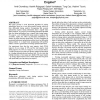Free Online Productivity Tools
i2Speak
i2Symbol
i2OCR
iTex2Img
iWeb2Print
iWeb2Shot
i2Type
iPdf2Split
iPdf2Merge
i2Bopomofo
i2Arabic
i2Style
i2Image
i2PDF
iLatex2Rtf
Sci2ools
DAC
2005
ACM
2005
ACM
How accurately can we model timing in a placement engine?
This paper presents a novel placement algorithm for timing optimization based on a new and powerful concept, which we term differential timing analysis. Recognizing that accurate optimization requires timing information from a signoff static timing analyzer, we propose an incremental placement algorithm that uses timing information from a signoff static timing engine. We propose a set of differential timing analysis equations that accurately capture the effect of placement perturbations on changes in timing from the signoff timer. We have formulated an incremental placement optimization problem based on differential timing analysis as a single linear programming (LP) problem which is solved to generate the new timing-optimized placement. Our experiments show that the worst negative slack (WNS) improves by an average of 30% and the total negative slack (TNS) improves by 33% on average for a set of circuits from a 3.0 GHz microprocessor that were already synthesized and placed by a lead...
| Added | 13 Oct 2010 |
| Updated | 13 Oct 2010 |
| Type | Conference |
| Year | 2005 |
| Where | DAC |
| Authors | Amit Chowdhary, Karthik Rajagopal, Satish Venkatesan, Tung Cao, Vladimir Tiourin, Yegna Parasuram, Bill Halpin |
Comments (0)

